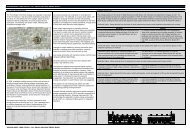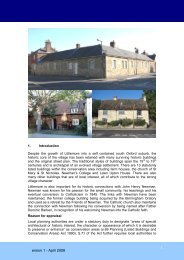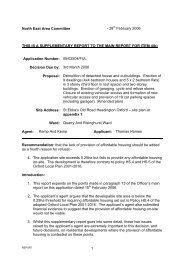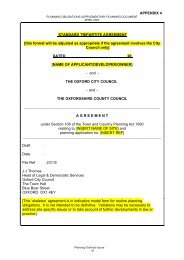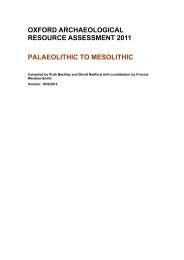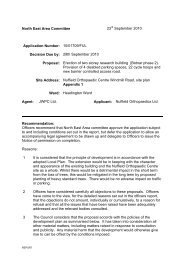Post-medieval Oxford - Oxford City Council
Post-medieval Oxford - Oxford City Council
Post-medieval Oxford - Oxford City Council
You also want an ePaper? Increase the reach of your titles
YUMPU automatically turns print PDFs into web optimized ePapers that Google loves.
Canals and waterways<br />
The <strong>Oxford</strong> Canal was built between 1769 and 1790, starting from Coventry and<br />
reaching New Road in 1790. Initially built as the main midlands connection, it was<br />
soon superseded by the Grand Union built in the late 18 th -19 th centuries (Durham et<br />
al. 2006: 431). A flash lock and two pound locks were added to the canal in 1790 at<br />
Medley, Godstow and Oseney. It was used for the carriage of goods until the 1950s<br />
when the section from Hythe Bridge to the New Road wharf was sold for the<br />
construction of Nuffield College. The canal is now used for recreation and has been<br />
maintained.<br />
An act was passed in 1601 intending to make the Thames navigable as far as<br />
<strong>Oxford</strong>. However, this did not appear to have had a significant impact until the mid-<br />
17 th century (Philip 1937: 152). By 1641, a wharf had been constructed at St Aldates<br />
for the collection of tolls from barges upon reaching the city and for their subsequent<br />
navigation upstream through the weirs and locks to Kings Sutton (ibid.: 154). The Old<br />
Lock Cut at Iffley on the River Thames is thought to be 17 th century in origin and an<br />
underwater inspection of the lock in 1998 recorded two phases of construction<br />
comprising mainly 18 th century features with some evidence of an earlier date<br />
(Wessex Archaeology 1998: 2). The Iffley Weir is part of an exceptional historic<br />
group comprising of the 1920s’ lock, keepers house, boat slide and bridge together<br />
with the listed 1630s’ lock that contains a 1922 Stoney Roller weir gate (Trueman<br />
2004: 29 and 40).<br />
The Binsey Boat<br />
An archaeological rescue excavation on the bank of the River Thames at Binsey<br />
recorded evidence of a boat of a late post-<strong>medieval</strong> date (Durham et al. 2006: 423).<br />
The boat had been partially exposed through erosion of the river bank, and the<br />
investigations also charted alterations to the riverbank over the last 120 years<br />
through cartographic analysis and geophysical survey (ibid.: 435). The geophysical<br />
survey recorded two parallel linear anomalies associated with the buried boat with<br />
several amorphous areas of magnetic anomalies probably representing scattered<br />
debris from the boat (Linford 2004: 4). The archaeological investigations recorded<br />
primarily 19 th century finds, indicating a date of deposition for the boat. However, the<br />
boat itself could not be reliably dated as the wood provided insufficient evidence for<br />
dendro-chronology (Durham et al. 2006: 445). The boat appears to have been a<br />
small working boat probably similar in form to a punt and was intended for<br />
commercial use rather than for pleasure (ibid.: 430).<br />
Canal wharfs<br />
Wharves were built by the <strong>Oxford</strong> Canal Company to unload the freight, principally<br />
coal. The coal wharves occupied the areas of the modern Worcester Street carpark<br />
and Nuffield College with land to the north used for offices. The wharves closed in<br />
the 1950s. Some of the buildings, for example Canal House and Wharf House, are<br />
now part of St Peter's College (VCH iv). Parts of the structure have survived in the<br />
walls of Worcester Street carpark (AOC 1998), while much of the infilled wharf<br />
remains below the surface of the carpark.<br />
A wharf or hithe at Hythe Bridge must have been the landing place for the upper<br />
Thames, and was certainly established by the 16th century. In 1861, it was known as<br />
Timber Wharf. In addition to timber, the dock was used for hay, slate and Cotswold<br />
stone (Hibbert 1988). By 1876, the wharf had closed with carriage transferred to the<br />
canal. A wharf and wet dock was also established north-east of Folly Bridge c.1629,<br />
which was the historic landing place for the lower Thames, and illustrated in early<br />
views. Following the changes to Folly Bridge in 1827, the wharf continued in use for<br />
two years and was sold in 1844 after which it became part of Salter's boatyard (VCH<br />
OXFORD ARCHAEOLOGICAL RESOURCE ASSESSMENT- POST MEDIEVAL<br />
30



